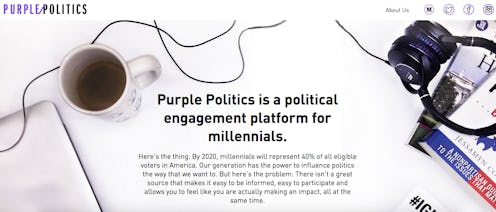News
This Has Been Called "The Skimm For Politics"

It doesn't really matter how much House of Cards you watch; the day-to-day of political activity can be a little dull. For example, if you haven't been sleeping very well, just read through the House of Representatives' floor proceedings. What's unfortunate about these political proceedings and actions, though, is that every single one of them will affect us in some way. To make this material more accessible, Rebecca Harris and Jennifer Sclafani started Purple Politics, a website and political newsletter that hopes to "explain complicated current issues in terms that were easy to understand and unbiased," as they told Bustle.
Specifically, Purple Politics is aimed at millennials. Harris and Sclafani note that the demographic will represent 40 percent of all eligible voters in America by 2020. The pair say that this means millennials have a "huge amount of political power, but that power isn't going to be tapped into unless we are informed and understand the problems that we want to solve."
Harris said that she first became interested in creating a simple platform that presented politics for millennials after interning on Capitol Hill. She tells Bustle of the time the Supreme Court was hearing the case for Obamacare, and healthcare reform was a common topic of conversation. "I got so frustrated discussing this topic, because everyone had such strong opinions about it, and I didn't feel informed enough about the Affordable Care Act to actually defend my stance," she says. "What I really needed was a source that just explained Obamacare in plain English to me. But that didn't exist."
Harris began Purple Politics to fill that need, and Sclafani, who studied design at the Pratt Institute, came on board to help "visually break down" complicated political issues. The site uses a stripped-down, image-driven homepage, and the amount of text in each article is minimal. Rather, it is organized in a graphical way, with small icons and lots of photos.
Some of the featured articles on the site's homepage include "What's Actually In The Iran Nuclear Deal?," "Money in Politics: The 2016 Campaign Breakdown," and "Income Inequality: What Should We Do About It?" Each article lays down the facts in plain view, and articles that cover partisan topics present both sides of the argument. The article on income inequality, for example, lists the common arguments for and against taxing the rich as a way to stimulate the economy.
The pair said that the name "Purple Politics" actually comes from their "commitment to explaining issues in an unbiased way," by acknowledging arguments from Republicans, who are often represented by the color red, and Democrats, who are often represented by the color blue. "Political partisanship in our country is at an all-time high, and we know that our generation is incredibly frustrated with Congress' inability to get things done because Republicans and Democrats can't come together and compromise," Harris says. "Our generation also cares more about the issues than political parties. So in the future, there is going to be a major call for more 'purpleness' in politics, and we want lead that effort."
In the long run, Harris said the goal of Purple Politics is to "make politics cool again" via chic, modern design and real social engagement with the issues. Harris said that's the site's next step: "building a platform that brings political participation into the digital space, where millennials are already engaging," so that millennials can help shape the policies that are going to affect their lives. "Content is just step one for us," she says. "We want to make it easy to be informed, but we also want to make it easier to participate in the democratic process and actually make an impact."
Images: Rebecca Harris/Purple Politics (4)